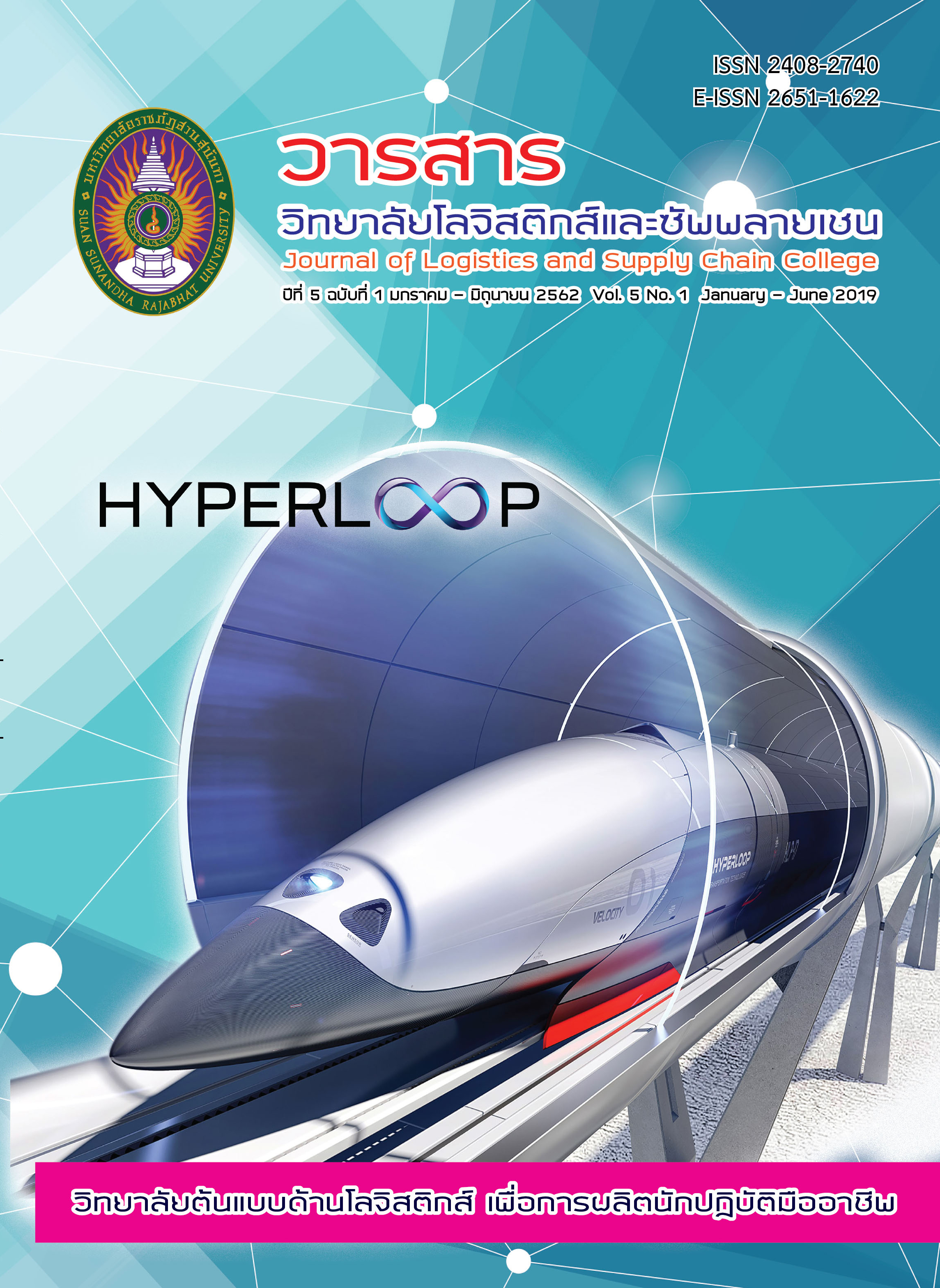ผลกระทบของการจัดการโลจิสติกส์เชิงบูรณาการที่ผลต่อความสามารถทางการตลาดในธุรกิจการท่องเที่ยวที่มีศักยภาพสูง
บทคัดย่อ
การวิจัยนี้เป็นการวิจัยแบบผสมผสานมีวัตถุประสงค์เพื่อ 1) ศึกษาปัจจัยที่มีอิทธิพลต่อความสามารถทางการตลาด ของธุรกิจการท่องเที่ยวของไทย และ2) เพื่อนำเสนอแบบจำลองความสามารถทางการตลาดขององค์กร โดยมีเครื่องมือคือแบบสอบถามและการสัมภาษณ์เชิงลึก (In-dept Interviews) ประชากรที่ใช้ในการศึกษาครั้งนี้คือคือกลุ่มธุรกิจการท่องเที่ยวที่มีศักยภาพสูงและจดทะเบียนในประเทศไทยจำนวน 2,899 องค์กร โดยศึกษาเฉพาะธุรกิจการท่องเที่ยวที่ให้บริการกลุ่มนักท่องเที่ยวตะวันออกกลาง การวิจัยเชิงปริมาณกลุ่มตัวอย่างที่ใช้ในการศึกษาจำนวน 352 องค์กรคัดเลือกกลุ่มตัวอย่างแบบง่าย (Simple Random Sampling) วิเคราะห์ข้อมูลโดยใช้เทคนิคการวิเคราะห์สมการเส้นทาง (Path Analysis) การวิจัยเชิงคุณภาพมีการคัดเลือกกลุ่มตัวอย่างแบบเจาะจง (Purposive Sampling) จำนวน 5 องค์กร ผลการวิจัยสรุปได้ว่า การจัดการโลจิสติกส์เชิงบูรณาการ มีอิทธิพลต่อความสามารถทางการตลาด โดยมีนัยสำคัญแสดงโดยค่า P-Value 0.007 ความไว้วางใจมีอิทธิพลต่อการจัดการโลจิสติกส์เชิงบูรณาการ มีนัยสำคัญแสดงโดยค่า P-Value 0.026 ความสัมพันธ์ส่วนบุคคลมีอิทธิพลต่อการจัดการโลจิสติกส์เชิงบูรณาการ มีนัยสำคัญแสดงโดยค่า P-Value 0.025 ผลการตรวจสอบความตรงของแบบจำลองความสามารถทางการตลาดขององค์กรเป็นจริงตามสมมติฐาน
เอกสารอ้างอิง
กระทรวงการท่องเที่ยวและกีฬา. (2554). แผนพัฒนาการท่องเที่ยวแห่งชาติ พ.ศ. 2554 – 2559. ค้นจาก: https://www.tica.or.th/images/plan_tourism2555-2559/2555-2559.pdf.
การท่องเที่ยวแห่งประเทศไทย. (2551). วิเคราะห์ศักยภาพของอุตสาหกรรมการท่องเที่ยวของประเทศไทย กองวิชาการการท่องเที่ยวแห่งประเทศไทย. กรุงเทพฯ: ผู้แต่ง.
ชัยฤทธิ์ ทองรอด. (2561). การจัดการการท่องเที่ยวเชิงเกษตร ล่องเรือชมสวน เลียบคลองมหาสวัสดิ์อำเภอพุทธมณฑลจังหวัดนครปฐม. วารสารวิทยาลัยดุสิตธานี, 12(2), 115 -130
Anderson, P. F. (1982). Marketing, Strategic Planning and the Theory of Firm. Journal of Marketing, 46(4), 15-26.
Chien-Yu Tsao., & Chin-Cheng Ni. (2016). Vulnerability, resilience, and the adaptive cycle in a crisis-prone tourism community. Tourism Geographies 18(1), 80-105.
Dubihlela, J., & Omoru, O. (2014). Barriers to effective supply chain management implementation, and impact on business performance of SMEs in South Africa. Journal of applied business research, 30(4), 1019-1030.
Ellinger, A. E., Daugherty, P. J., & Keller, S. (2000). The relationship between marketing logistics interdepartmental integration and performance in U.S. manufacturing firms: An empirical study. Journal of Business Logistics, 21(1), 1-22
Kerdpitak, C., & Heuer, K. (2013) Influencing of marketing competency in aviation industry. International journal of business tourism and applied sciences, 1(1), 1-11
Kerdpitak C., & Heuer, K. (2016) Key success factors of tourist satisfaction in tourism services provider. Journal of Applied Business Research, 32(4), 1237-1242.
Kerdpitak, C., (2017) Factors leading to success of tourism business in Bangkok in Bangkok Thailand. Journal of Applied Business Research, 33(3), 1-9.
Klein, R. (2007). Customization and real time information access in integrated e-business supply chain relationships. Journal of operation management, 25(6), 1366-1381.
Lovett S, Simmons LC, & Kali R. (1999). Guanxi versus the market : ethics and efficiency. International Journal of Business Study, 30(2), 231-248
Panayides, P. M. (2007). The Impact of organizational learning on relationship orientation, logistics service effectiveness and performance. Journal of Industrial Marketing Management, 36(1), 68-80.
Pennington-Gray, L. (2014). Developing a Destination Disaster Impact Framework. Tourism Analysis, 19(1), 105-110.
Paulraj, A., & Chen, I. J. (2007). Strategic Buyer-Supplier Relationships, Information Technology and External Logistics Integration. The Journal of Supply Chain Management, 43(2), 2-14
Stank, T. P., Daugherty, P. J., & Ellinger, A. E. (1999). Marketing Logistics Integration and Firm Performanc. International Journal of Logistics Management, 10(1), 11-24.
Vargas, G., Cardenas, L. & Matarran, L. (2000). “Internal and External integratation of assembly manufacturing activites. International Journal of Operation and Production Management, 20(7), 809-822.
Xue, L., Ray, G. & Sambamurthy, V. (2013). The impact of supply chain electronic integration on customer service performance. Journal of operations management 82(9) 1-3
Yamane, T. (1973). Statistics: An Introductory (3rd ed). New York Harper and Row
Zacharia, Z. G., & Mentzer, J. T. (2004). Logistics salience in a changing environment. Journal of Business Logistics, 25(1), 187-210.



